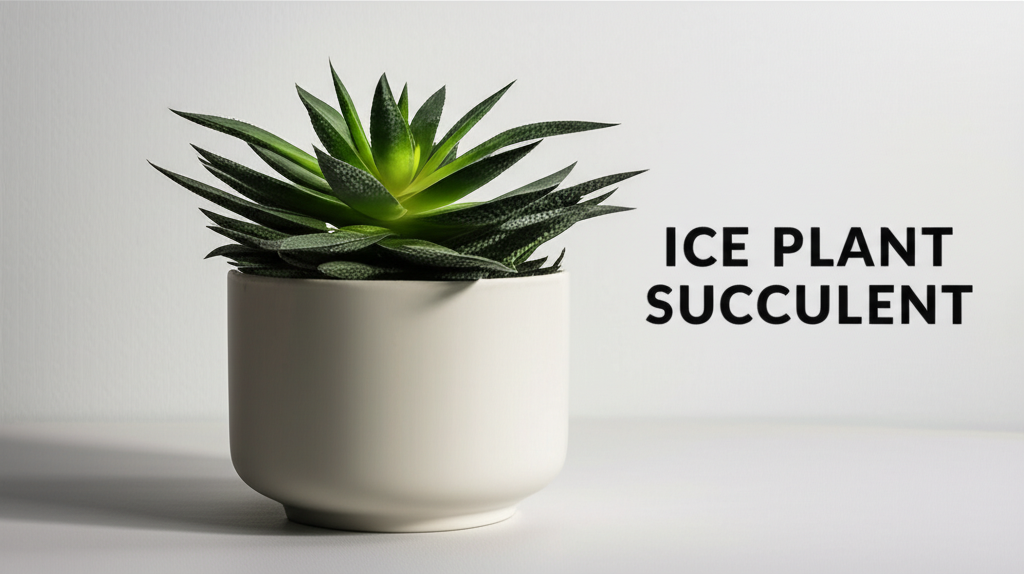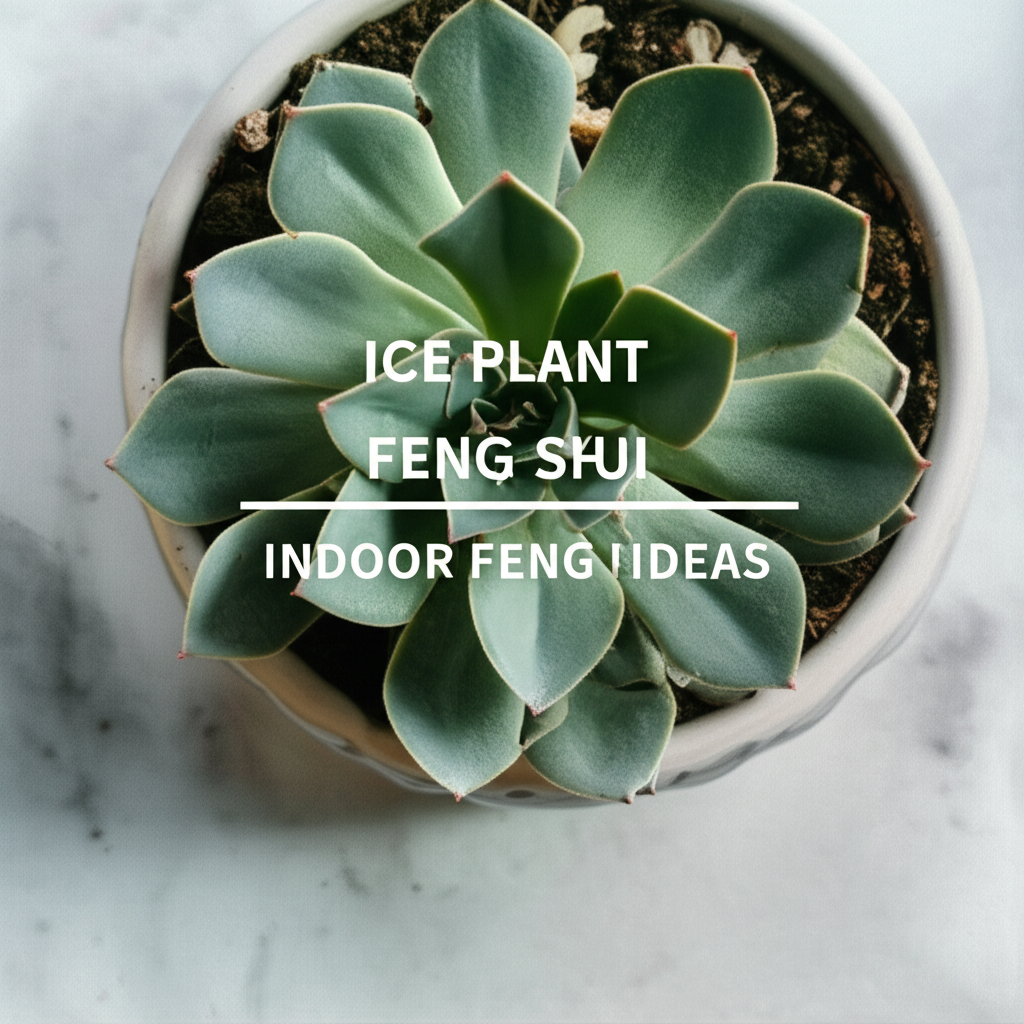The Mesmerizing Appeal of the Ice Plant Succulent Indoors
The world of houseplants is vast and varied, but few capture the imagination quite like the Ice Plant succulent. Known scientifically as various genera within the Aizoaceae family, these fascinating plants boast unique, crystalline structures that give them their evocative name. Far from being frosty, these succulents are brimming with life and can bring a refreshing aesthetic and a touch of tranquility to any indoor space. Beyond their striking appearance, ice plants have increasingly found favor among enthusiasts of Feng Shui, the ancient Chinese practice of harmonizing individuals with their surrounding environment. This article delves into the captivating world of ice plant succulents, exploring their characteristics, care needs, and their potential to enhance the energy flow and aesthetic appeal of your home according to Feng Shui principles.
Understanding the Ice Plant Succulent
The term “ice plant” actually refers to a diverse group of succulents, many of which originate from the arid regions of South Africa. What sets them apart is their remarkable adaptation to dry conditions, manifesting in a variety of fascinating forms. Some are low-growing groundcovers, while others form small, shrub-like mounds. Their most distinctive feature, however, is the presence of specialized cells called “papillae” or “vesicular epidermal cells.” These cells are filled with water and often have a translucent or crystalline appearance, resembling dew drops or ice crystals clinging to the leaves. This unique characteristic contributes to their name and makes them a visual delight.
Common examples of ice plants include:
- Lithops (Living Stones): Perhaps the most famous ice plants, these succulents have evolved to perfectly mimic pebbles and stones, often with a fissure on top from which their flowers emerge.
- Conophytum: These small, button-like succulents are often found in clusters and can resemble tiny pebbles or seeds.
- Pleiospilos (Split Rock Succulents): These resemble split rocks with two or more leaf-like structures that can develop into intricate patterns.
- Mesembryanthemum: A broader genus that includes many species with attractive, glistening leaves.
The diversity in their appearance means there’s an ice plant to suit almost any taste, from the incredibly camouflaged Lithops to the more openly crystalline varieties.
Bringing the Ice Plant into Your Home: Practical Considerations

While their beauty is undeniable, successfully growing ice plant succulents indoors requires understanding their specific needs. These are not your average houseplants; they are desert dwellers at heart and thrive on neglect rather than constant attention.
Light Requirements
This is arguably the most crucial factor for ice plant success. They need bright, direct sunlight for at least 6-8 hours a day. A south-facing window is ideal. Insufficient light will lead to etiolation (stretching and becoming leggy) and a loss of their characteristic compact form and vibrant colors. If natural light is insufficient, a grow light specifically designed for succulents can be a viable alternative.
Watering Wisdom
Overwatering is the quickest way to kill an ice plant. Their fleshy leaves and specialized water-storing cells make them incredibly drought-tolerant. The best approach is to water sparingly and deeply, allowing the soil to dry out completely between waterings. This typically means watering only once every few weeks, or even less during cooler months. Observe the plants: if the leaves appear slightly shrunken or leathery, it’s a sign they are ready for water.
Soil and Drainage
Excellent drainage is paramount. Use a well-draining potting mix formulated for succulents and cacti. You can also create your own by mixing potting soil with perlite or coarse sand in a 1:1 ratio. Planting in pots with drainage holes is non-negotiable.
Temperature and Airflow
Ice plants prefer moderate temperatures, typically between 65-75°F (18-24°C) during the day. They can tolerate slightly cooler temperatures at night. Good air circulation is also beneficial, helping to prevent fungal diseases, especially in humid environments.
Fertilizing
These plants are not heavy feeders. A light feeding with a diluted succulent fertilizer once or twice during the growing season (spring/summer) is usually sufficient. Avoid fertilizing during their dormancy period in winter.
Ice Plant Succulents and Feng Shui: Harmonizing Energy
Feng Shui is about creating balance and harmony in your living space to promote well-being and prosperity. Plants play a significant role in this practice, acting as conduits for natural energy, or Qi. Ice plant succulents, with their unique characteristics, can be thoughtfully incorporated into a Feng Shui strategy.
The Symbolism of Ice Plants in Feng Shui
The crystalline structures of ice plants are often interpreted in Feng Shui as representing clarity, purity, and a refreshing energy. Their ability to store water speaks to resilience and abundance, while their slow, steady growth can symbolize patience and long-term prosperity.
Placement Strategies for Ice Plants
The placement of any plant in Feng Shui is crucial. For ice plants, consider the following:
- The Wealth Corner (Southeast): Placing vibrant, healthy plants in the southeast sector of your home or a room is traditionally associated with attracting wealth and abundance. The unique, almost gem-like appearance of some ice plants can lend an air of preciousness to this area.
- The Fame and Reputation Corner (South): The vibrant colors and interesting shapes of ice plants can symbolize growth and recognition in the south sector, representing your public image and reputation.
- The Health and Family Corner (East): Healthy, thriving plants are always beneficial for this sector, promoting vitality and familial well-being.
- Areas Needing Refreshment: Ice plants can be excellent choices for areas that feel stagnant or lack vitality. Their “cool” aesthetic can bring a sense of calm and rejuvenation.
It’s important to remember that the plant must be healthy and thriving to bring positive Feng Shui. A wilting or unhealthy plant can have the opposite effect.
Complementing Other Elements
The earthy tones and crystalline textures of ice plants can be beautifully complemented by other Feng Shui elements. Consider placing them near:
- Ceramic Pots: Earth elements, represented by ceramic, can ground the energy of the plant.
- Water Features (Small): In Feng Shui, water and earth elements work in harmony. A small tabletop water feature placed near your ice plant could symbolize the flow of abundance.
- Crystals: Pairing ice plants with other natural crystals can amplify their positive energy.
Conversely, avoid placing them directly near metal elements in a way that creates a clash of energies, though this is a more nuanced aspect of Feng Shui.
Aesthetics and Versatility: Beyond Feng Shui
While Feng Shui principles can guide their placement, the aesthetic appeal of ice plant succulents is a significant draw in itself. Their unique forms and textures offer a departure from more traditional houseplants, adding a contemporary and sculptural element to interior design.
Creating Eye-Catching Arrangements
Ice plants are often small and slow-growing, making them ideal for terrariums, miniature rock gardens, or as focal points in mixed succulent arrangements. Their distinct shapes can create fascinating visual contrasts when placed alongside plants with softer foliage or different textures.
Low-Maintenance Beauty
For busy individuals or those new to plant care, ice plants are excellent companions. Their low maintenance requirements mean you can enjoy their beauty without the stress of constant attention, fitting seamlessly into modern lifestyles.
The “Cool” Factor
The name “ice plant” itself evokes a sense of cool, crisp beauty. This can be particularly appealing in warmer climates or for creating a refreshing ambiance in a room. Their crystalline surfaces can catch the light in intriguing ways, adding a dynamic element to your decor.
Key Facts and Comparison
To better understand the ice plant succulent, let’s summarize its key characteristics and compare it to some common houseplants.
| Feature | Ice Plant Succulent | Fiddle Leaf Fig | Snake Plant | Peace Lily |
|---|---|---|---|---|
| Light Needs | High, direct sunlight | Bright, indirect light | Low to bright, indirect light | Low to bright, indirect light |
| Watering Frequency | Very low (allow soil to dry completely) | Moderate (allow top inch of soil to dry) | Low (allow soil to dry completely) | Moderate (keep soil consistently moist but not soggy) |
| Water Storage | High (in leaves and stems) | Moderate (in trunk and leaves) | High (in leaves) | Low |
| Humidity Needs | Low | Moderate to high | Low | Moderate to high |
| Aesthetic | Unique, crystalline, sculptural | Large, statement leaves, tropical | Architectural, upright leaves, modern | Elegant, arching leaves, classic |
| Feng Shui Potential | Clarity, purity, resilience, refreshing energy | Growth, expansion, vitality | Protection, strength, adaptability | Peace, purity, air purification |
This table highlights the distinct requirements and aesthetic contributions of ice plant succulents compared to other popular indoor plants.
Troubleshooting and Care Tips
Even the most resilient plants can encounter issues. Here are some common problems and their solutions for ice plant succulents:
- Mushy or Rotting Leaves: This is almost always a sign of overwatering. Allow the plant to dry out completely, and ensure excellent drainage. You may need to repot with fresh, dry soil if rot is severe.
- Stretching (Etiolation): Insufficient light. Move the plant to a brighter location or provide supplemental grow light.
- Shriveled Leaves: While they can indicate thirst, severe shriveling can also be a sign of root rot due to overwatering, preventing water uptake. Check the soil moisture and roots.
- No Flowers: Some ice plants only flower after reaching maturity or under specific conditions of reduced watering during their dormancy period. Patience is key.
Seasonal Care for Ice Plants
The care for your ice plant will vary slightly throughout the year:
- Spring/Summer (Growing Season): Provide ample light and water sparingly when the soil is completely dry. Fertilize lightly if desired.
- Autumn/Winter (Dormancy): Many ice plants enter a period of dormancy during the cooler, darker months. Significantly reduce watering, perhaps only once during the entire season, and ensure they are in a cool, bright location. Avoid fertilizing.
Pros and Cons of Ice Plant Succulents
To make an informed decision about incorporating ice plants into your home, consider their advantages and disadvantages.
| Pros | Cons |
|---|---|
| Unique and striking appearance | Require very bright, direct sunlight which can be hard to find indoors |
| Extremely drought-tolerant and low-maintenance | Susceptible to root rot if overwatered |
| Slow growth, making them suitable for small spaces | Can be sensitive to over-fertilization |
| Can enhance Feng Shui by bringing clarity and purity | Limited species readily available compared to more common succulents |
| Visually refreshing and can add a “cool” element to decor | Some varieties can be delicate and easily damaged |
This balanced perspective should help you decide if an ice plant succulent is the right fit for your home environment and your plant care routine.
Conclusion: A Cool and Cultivating Choice
The ice plant succulent offers a unique blend of striking natural beauty, resilient growth, and intriguing Feng Shui potential. Their crystalline structures and drought-tolerant nature make them a fascinating addition to any indoor garden, especially for those seeking low-maintenance yet high-impact greenery. By understanding their specific light and watering needs, and considering their placement according to Feng Shui principles, you can cultivate these remarkable plants to not only enhance your home’s aesthetic but also to bring a refreshing and harmonious energy into your living space. Whether you are a seasoned plant enthusiast or a beginner looking for something truly special, the ice plant succulent is a cool and rewarding choice that is sure to captivate and delight.


